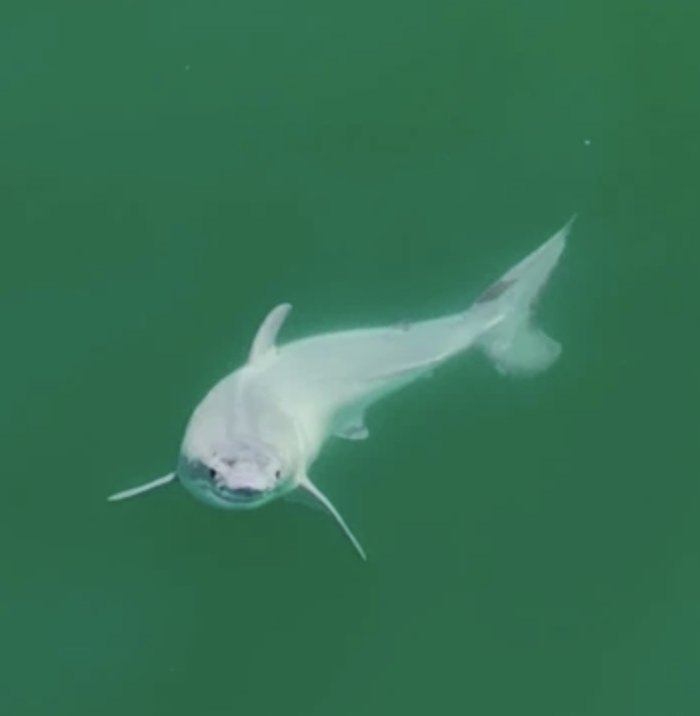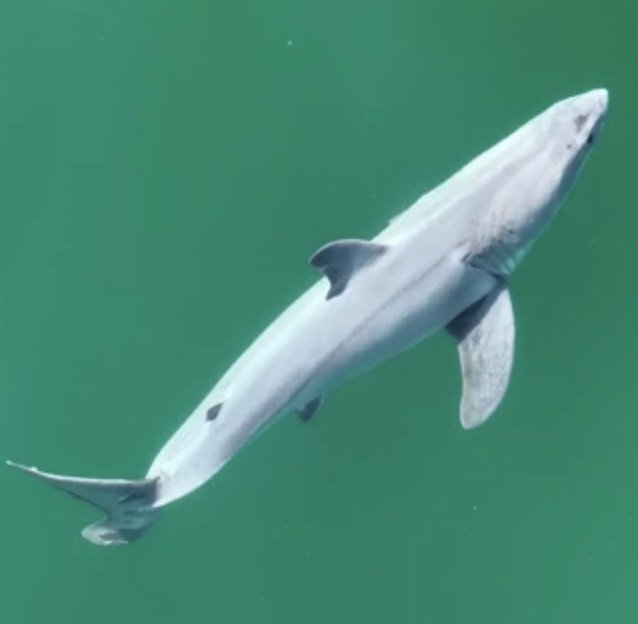In the summer of 2023, Carlos Guana, a wildlife filmmaker and storyteller, and Phillip Sternes, a biology doctoral student at the University of California Riverside, set out on an expedition off the central coast of California to film great white sharks and other wildlife in the Pacific waters near Santa Barbara.
On July 9, 2023, while operating his Mavic 3 Pro aerial drone approximately a quarter mile off the coast of Carpinteria, California, Guana spotted something striking and beautiful moving beneath the ocean surface.
Although the creature was familiar in appearance—a small, almost ghostly pale white shark—neither Guana nor Sternes immediately recognized what the drone’s camera had managed to capture at the time.
It wasn’t until later while rewatching the footage that they noticed something odd about the shark’s appearance.
“Upon close examination of video and photos, the individual’s pale color appears to be a thin white film covering the shark,” Guana and Sternes would later write. “We noted that as the shark was swimming, the whitish film was being sloughed off.”


Although it seemed possible that the unusual film might have been caused by some kind of skin disorder that neither of the observers recognized, nor could it be found in the available literature on white sharks, a more likely possibility soon presented itself: this might be the remains of intrauterine material left over from the creature’s seemingly very recent birth.
If the latter were true, it would be an unprecedented sighting, given that what Guana and Sternes had filmed was likely a baby great white shark and the first of its kind ever captured on film.
“We enlarged the images, put them in slow motion, and realized the white layer was being shed from the body as it was swimming,” Sternes said in a recent statement about their discovery.
“I believe it was a newborn white shark shedding its embryonic layer.”
Now, their discovery has been reported in a new paper that appeared in the Environmental Biology of Fishes journal.
Great whites are among the most famous shark species, partially due to their famous, monstrous depiction in films like Jaws. Despite the attention the species has received, many things about them remain mysterious to ocean scientists.
Guana, who is known online as The Malibu Artist, has filmed these and other species of sharks in locations all over the world, documenting an impressive amount of footage of the creatures where they are often shown swimming frighteningly close to beachgoers.
His footage of these enigmatic ocean predators has racked up millions of views online, but the new images could offer scientists new clues about one of the most perplexing mysteries involving great white sharks.
“Where white sharks give birth is one of the holy grails of shark science,” Guana said in a statement. “No one has ever been able to pinpoint where they are born, nor has anyone seen a newborn baby shark alive.”
“There have been dead white sharks found inside deceased pregnant mothers,” Guana says, “But nothing like this.”


Like mammals, young great sharks are born live, and it is believed that they might feed on unfertilized eggs while still in the embryonic stage, along with a milky substance secreted within the uterus of the mother that provides additional nourishment.
It is the remnants of this intrauterine milk that Sternes and Guana believe they observed on the shark they filmed last July.
Other key observations also point to the likelihood that what they filmed represents the first imagery of a baby great white shark. While filming in the area, the pair observed several very large—and potentially pregnant—female great whites nearby.
By comparison, the small shark they captured in imagery with Guana’s drone is very small, and its appearance and behavior both suggest a very young creature—perhaps as little as a day, or even just a few hours old.
Also of interest is that the coastal waters of central California had already been put forward in the past as a potential birthing location for great whites. Hence, the pup that Guana and Sternes observed was in the right place, and at the right time, to be a likely match for a newborn great white.
White sharks are a protected species, although Guana and Sternes note in their paper that fishermen do sometimes inadvertently catch these sharks, some of which may die resulting from stress or injuries.
If the central California coast is indeed a breeding ground for white sharks, as opposed to waters much further offshore, as some past studies have suggested, then a greater level of management may be required to help ensure the conservation of the species and their habitat.
Ultimately, Guana and Sternes write that their aerial drone footage “has provided shark science with another interesting set of information,” adding that “future drone observations of sharks in this area will greatly improve our knowledge and understanding of white shark life history.”
Their recent paper, “Novel aerial observations of a possible newborn white shark (Carcharodon carcharias) in Southern California,” can be read online here, along with additional imagery of the white shark they observed in July 2023.
Micah Hanks is the Editor-in-Chief and Co-Founder of The Debrief. He can be reached by email at micah@thedebrief.org. Follow his work at micahhanks.com and on X: @MicahHanks.

